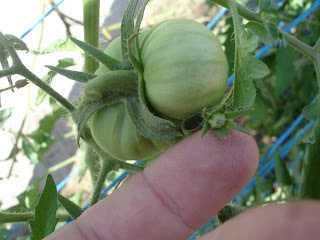 |
| Volcan Chinchontepeque |
So I came back from my Christmas vacation (which was wonderful, by the way) half expecting my plants to be dead. I had a friend come water them while I was gone, but I didn't explain anything about any pesticides. I was partially right and partially wrong. The eggplant was brutally attacked, probably to the point of no return. Seeing as I don't even like eggplant a whole lot, I decided it wouldn't be worth the recitation, and down they went (I didn't take pictures). Everything else was doing pretty well, to my delight.
Well, I guess not everything. This hanging plant wasn't doing so hot. The leaves had withered, and there was practically zero fruit or flowers. I decided to cut it back to the main stem in the hopes that it would come back to life. I left a couple of the old leaves, thinking that it would probably need some kind of photosynthesis to stay alive. And sprout back alive it did. This photo was taken a week or two after I pruned it back, and you can see the new sprouts forming.
In the top of my hanging planter, the cilantro was growing like wild. I was making every dish I could think of with cilantro in it to use all of it up. I had a constant supply of chirimol (AKA pico de gallo) in my fridge, and loved every minute of it. While I was on vacation, it began to bolt. When I got back, not knowing much about cilantro/coriander, I let it bolt instead of cutting it back to produce more leaves. Once it got to about 2 feet tall it began to flower and later to produce seeds (to either plant again, or eat as coriander).
The plant hanging out of the 3-liter was doing a little bit better than his hanging counterpart, but not by far. I also pruned him back in the hopes that he would keep going. This photo was taken the same day as the above photos, which were all taken several days (possibly a week or so) after I pruned them back. This plant was much quicker to come back, and at this point it even had little green tomatoes on it.
 Which brings me to the heirlooms. They had been growing like crazy while I was gone. I told the kid I had watering them how to tie them up to the bamboo posts I had put in, and they were barely holding them up. I had to do something, and had to do it soon. At this point I had been to several local farmer's tomato plots, and learned the local way of tying up your tomatoes. Typically the plants are in the ground and in lines of several hundred plants, but I figured I could adapt the same idea to my plants. They put a post at the beginning and end of each row, with posts about every 10 feet in between. They tie a nylon twine to the beginning post, and go from post to post wrapping the twine on both sides. As the plants grow, they continue wrapping twine higher and higher created a guide system for the plants as they grow. I decided that with a little Jimmy-rigging, twine, wire, and some old wood I could create the same thing for my plants. The only difference was that my plants were already big, which required much more care in tying up the tutors.
Which brings me to the heirlooms. They had been growing like crazy while I was gone. I told the kid I had watering them how to tie them up to the bamboo posts I had put in, and they were barely holding them up. I had to do something, and had to do it soon. At this point I had been to several local farmer's tomato plots, and learned the local way of tying up your tomatoes. Typically the plants are in the ground and in lines of several hundred plants, but I figured I could adapt the same idea to my plants. They put a post at the beginning and end of each row, with posts about every 10 feet in between. They tie a nylon twine to the beginning post, and go from post to post wrapping the twine on both sides. As the plants grow, they continue wrapping twine higher and higher created a guide system for the plants as they grow. I decided that with a little Jimmy-rigging, twine, wire, and some old wood I could create the same thing for my plants. The only difference was that my plants were already big, which required much more care in tying up the tutors.
 |
| Top View. |
 |
| This guy was still doing great, producing plenty of tomatoes. |
At this point, the heirlooms were doing great. I did, however, have a perpetual problem with one pest. In Spanish it is called a minador, which in English translates to miner, but I'm not sure if that's the word we use for them. They are little bugs that in the larvae stage eat the inner layer of the leaves, leaving little hollow tunnels. Eventually they eat so much that the plant has a tough time absorbing light. I tried various products to get rid of them, all of them reducing the population some, but they eventually come back. You can see them in one of the above pictures.















